“My name is Dolkar and I am from a remote village of Padum region in Zangskar,” said a student who was given the responsibility of taking us around a school campus in Ladakh. “Initially when we joined here, it was too tiring to even take one round of the school, but now, as it is ‘my responsibility’, I got used to it,” she continued. I was surprised to see a young girl like her being so conscious of her responsibility. Moreover, she had just come from a village that is hardly connected to the other parts of the Ladakh region and was now confidently conversing and showing the school campus to the strangers.
The school building seemed quite small and on its entrance, I could see a tag that said, ‘The Winner of the Global Awards for Sustainable Architecture’, as I read it curiously, Dolkar clarified that the building was made completely out of mud and it also had the temperature control technique. As we entered, we were stunned looking at the usage of the waste products in making the building. The tetra-packs and the waste papers were stuffed in the glass boxes that can receive at least a little sunlight. This system naturally controlled the temperature of the building mostly at 15 degrees. When I asked who constructed the building so creatively, quickly came the answer that it was the ‘responsibility’ of the students of solar power study.
It was unbelievable that the students of such simple school in the outskirts of Leh doing such unbelievable tasks. It really seemed like ‘3 Idiots’ fame Rancho’s school. And yes. You guessed it right. While most of the tourists flood at the Lotud Druk School where the shooting was done, the real school of Sonam Wangchuk AKA Phunsuk Wangdu is missed by many travellers.
The school accepts only the students who are failed by the conventional academic system. Here, the students are taught in a different manner considering their visual, auditory and motor skills. The moment you enter, you would not find the students with books in their hands but experimenting with the things of their choice.
Let’s take a photo tour inside this campus of the School that focuses more on reading, conversation, creativity, business and science. Challenging the conventional system, these students of Sonam Wangchuk are proving their capability in front of the world.
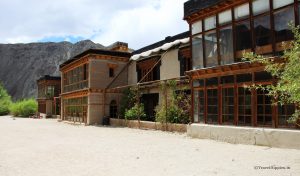
Also Read: My Solo Adventure in Ladakh
The school isn’t just a school for the students here, it’s a movement, a revolutionary movement of the Ladakhi students in the field of education and culture. They don’t study to become an engineer, doctor of CA. They just learn to bring change in the barren land of Ladakh. They don’t move away from their culture in a race of being modern and avoiding agriculture but aim that the Ladakhis are benefited by their education and can achieve something without renouncing this barren land.

The 3 R’s is the main motto of the school and the real education for them is being able to create something useful out of the waste brought in by the tourists at Ladakh. And the exercise of their brain begins from here. I remember teaching my VI Grade kids, the meaning of waste, types of waste and waste segregation merely from the textbook, discussions and mere examples. But, this school believes in putting all textual theories into practice. The students back in Mumbai, studying in reputed schools mostly fail to understand it completely, but the Ladakhi students here don’t only understand but also deal with it like a boss. And for your info, students here don’t have to pay a single penny for education. How?? How does the School survive then? Scroll down to know the answer.

This is where it all starts from. Each child listens to the objectives of their school and is vested upon with a ‘responsibility’. The responsibilities range from guiding a campus tour, looking after the kitchen, cleaning the campus, maintaining the greenhouse or the natural refrigerators, manage the electricity supply to the school through solar panels and so on. The school, thus hardly need any employee for the maintenance work and on the other hand, it makes the students feel that the school as their own home and responsibility.
The students are not only taught main subjects but are also taught the values like helping, not lying or cheating, being dedicated to the given task and no gossiping.

As the picture says, the area is of the students, by the students and for the students. The recreational activities range from indoor games to singing and dancing on the traditional songs of Ladakh. The school has the cultural committee that learns the songs from a Ladakhi teacher and later performs in front of the other students, volunteers and guests. Mostly, new students are given the chance to perform so that they develop the confidence and the appreciation of others cab break the ice between them. The dinner which they enjoy together is followed by a news watching session and discussion on several issues.
Also Read: Budget Home Stays in Ladakh
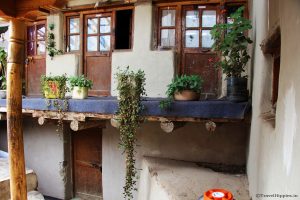
The students have to decorate or beautify their own rooms along with cleaning and maintaining the same.
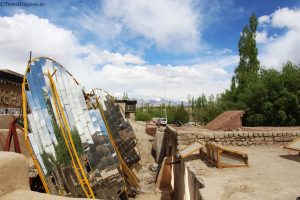
At first, the onlookers might be surprised to see the mirror pieces forming a huge concave mirror. Only when you move down in the kitchen, you realise that the sun rays are reflected on the smaller pieces put instead of firewood in a stove. Once you keep a huge vessel of water on the same, the water would remain hot throughout the day. No coal, no wood required! And what is the investment? just the waste pieces of mirrors from a hotel that opts for renovation and discard the old mirrors. Who created? The students themselves with the guidance of the teachers. Isn’t it what we call ‘education’?
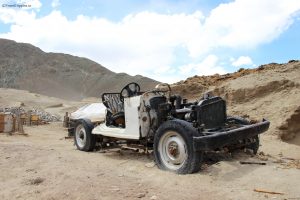
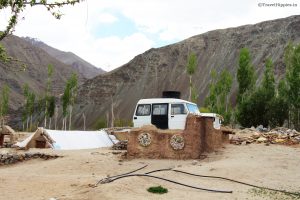
A car house which has a cool balcony in the form of a cozy car seat and the windows. And the cabin is certainly not so tiny as you think. The real room lies under the ground which also keeps it cool in summers and warm in winters. The interior too is really fascinating, check out the next picture for the same.
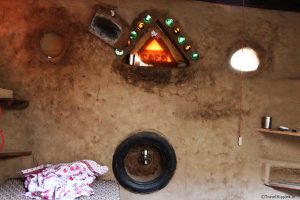
The mud house has the shelves to keep the things and colourful ventilation window too. And the Tyre has been used the best way. The water in the underground tank doesn’t freeze even in winters, and thus is the most sensible way to have the running water in your cabin.
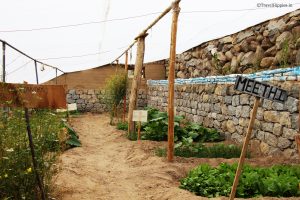
But, the children here are certainly educated well to make impossible possible. During the springs and summer in Ladakh, the greenhouse is built and maintained by the newly enrolled students. The produced vegetables are then directly supplied into the school kitchen and the excess are stored in the natural underground fridge where the temperature is always maintained below eight degrees. The veggies that are the monopolies of hotter regions are thus easily grown in these makeshift low-cost greenhouses.
The system isn’t only practised by the school but is also taught to the farmers all across Ladakh. If you would ever opt for a homestay, such greenhouses are especially found in all Ladakhi homes. While the students in the city just draw the Green House Effect diagrams and score ten on ten, these kids are able to put it into practice. And even teach it to their family members.
This is done apart from other scientific methods used in normal farms in the school. The students maintain the poultry farm and the cows that provide fresh milk to them. And when you end the campus tour, you would be served the tea made with such fresh cow milk!
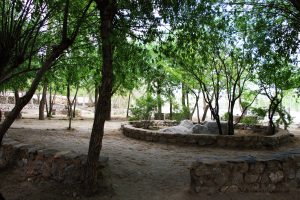
The ancient system at Shantiniketan having open classrooms amidst the nature is well-known, but in the barren land of Ladakh creating such a shadowy place in a school is a challenging task. It might have taken years to create such a wonderful arbour of huge trees but this place must be the most memorable one for most of the students and volunteers who spend their evenings in English conversation classes under these thickets.
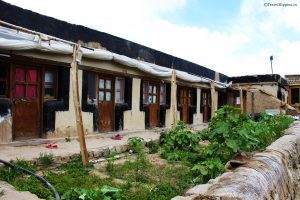
Won’t you love your job when every morning you are greeted by a blooming flowerbed and bushes right out of your quarter at your work place? So, being a teacher in this school is equally wonderful as being a student.
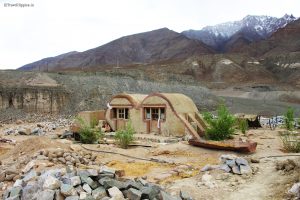
Those cabins were just the quarters of some solar studies graduates in the school, but, wait till you enter the rooms. The rooms are now the power stations which transmit the electronic energy generated by the solar panels installed in the campus. Obviously, you can’t expect the usual solar panels in this school. The panels here detect the direction of the sunlight and rotate itself in order to make the most efficient use of the available sunlight throughout the day.
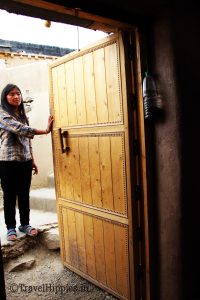
Yes!! That bottle filled with sand is the door closer with ‘Zero’ investment. And you can even try doing the same with your office doors.
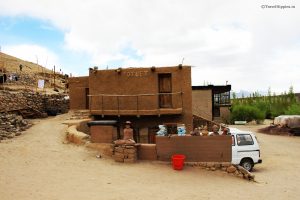
The school students have brought laurels by setting up successful start ups under the mentoring of the school faculties. One such well-known example is Ladakhi Women’s Travel Company that has also been appreciated by BBC Travel. A team of students have also been successful in making artificial Stupa at Phey.
Sonam Wangchuk is soon coming up with a new institution named The University of Alternative studies – Ladakh. The business studies students here would be running their own business firms while the architecture students will design and construct the buildings for people and for themselves. Isn’t it how we all wish to learn the things?
Certainly, the future of the Ladakhi kids is too bright.
………..
Don’t want to miss such wonderful stories?
Subscribe my blog and regularly get the updates in your inbox and do not forget to follow me on facebook .
[instagram-feed num=6 cols=6]

I liked your post. We’ll written with beautiful pictures 👍 Thanks for sharing 🙂
Not the usual thing you read on a travel blog – this is a really thoughtful and well compiled article. It sounds brilliant that the kids’ sense of entrepreneurship is being encouraged. A fascinating read – thank you.
This is so interesting! The kids sure are really innovative. Bright futures for them indeed 🙂
Unbelievable! Thanks for bringing a world from this place. I would never came across it, if not your post. I really love bloggers covering such things, instead of generic sights in cities. This place deserves to be covered by Nat Geo, I would love to shoot there a documentary as well!
This is really cool. I had no idea there were school like this out there. I’m so glad the students are able to have a place like this. How did you come across this?
Hi, a local guide in Ladakh is an alumni of this school and thanks to him we could reach this hidden gem.
Hi, a local guide in Ladakh is alumni of this school and thanks to him we could reach this hidden gem.
Wow! That’s a place where I would like to send my daughter for sure!! Sounds like they are following what a Montessori or Emilio regalia method would do. I wish more and more schools would take approach and truly educate kids. I am not surprised kids who didn’t “do well” at conventional system are doing great over there, since conventional system aren’t meant to truly educate anybody. I sooo wish this school was here!!!
Education as we know it really needs to change – the things most kids are taught are basically useless in the real world, and can mostly be found on google or self-taught. We definitely need more schools like this to tackle the world’s problems in a real way. Totally inspiring!
Woow.. Such an interesting place to visit! I love how unconventional the school’s teaching method is. A great way to enhance the students’ knowledge and skills. I’m so impressed by the facilities more so because they are created by the students. Its so lovely to be able to see such old and discarded things turned into awesome equipment!
Fascinating story and very interesting post! Thank you for sharing, it is great to see how different places in the world invest in youth!